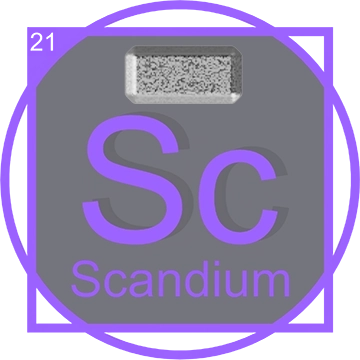Scandium (Sc): An Extensive Overview
Welcome to an in-depth exploration of Scandium (Sc), a transitional metal known for its significant role in various scientific and technological domains. This article aims to provide a comprehensive understanding of Scandium, covering all facets from its initial discovery to its diverse applications across different fields. Our journey through the realm of Scandium will highlight its chemical properties, economic importance, and emerging roles in new technologies, ensuring a thorough appreciation of this intriguing element.
Scandium Discovery: A Historical Perspective

Scandium was discovered in 1879 by Swedish chemist Lars Fredrik Nilson. He identified this element while analyzing euxenite and gadolinite minerals that originated from Scandinavia, which directly influenced the naming of the element as 'Scandium'. This discovery was not just a mere addition to the periodic table; it significantly enhanced the understanding of the rare earth elements group. Nilson's work paved the way for future studies on Scandium's unique properties and potential uses, marking a pivotal point in the history of chemistry.
Scandium in the Periodic Table
Scandium holds the atomic number 21 in the periodic table. As a member of the transition metals, it features properties common to both the rare earth elements and lighter transition metals. Scandium's placement in the periodic table signifies its unique role as a bridge between these two categories, influencing its chemical behavior and reactivity.
Properties of Pure Scandium

Pure Scandium is distinguished by its exceptional characteristics that set it apart in the periodic table. This silvery-white, metallic d-block element is often classified as a rare earth element due to its sparse occurrence and the complexities associated with its extraction from rare minerals. Pure Scandium boasts a higher melting point of 1541°C and a lower density than aluminum, contributing to its desirability in crafting high-performance materials. Its ability to endure extreme conditions and its compatibility with other metals make it incredibly useful in the creation of various high-strength alloys used in aerospace and other advanced technological applications.
Scandium Applications in Science and Lighting

In the scientific community, Scandium is esteemed not only for its catalytic properties but also for its role in enhancing high-intensity lighting solutions. This rare earth metal is a key component in the production of Scandium iodide, which is utilized in mercury vapor lamps. These lamps are favored for their ability to produce a light source that closely mimics natural sunlight, offering superior light quality that is essential in various applications such as film production and large-scale indoor lighting. Moreover, the addition of Scandium to these lamps increases their efficiency and lifespan, making Scandium an invaluable element in advanced scientific lighting technologies.
Scandium Applications in Technology

One of the most thrilling and transformative applications of Scandium is observed in the field of aerospace engineering. The strategic addition of Scandium to aluminum alloys not only significantly enhances their strength and durability but also improves their resistance to corrosion, which is essential for the harsh conditions of aerospace operations. This has led to the widespread use of Scandium-aluminum alloys in the manufacturing of critical aircraft and spacecraft components, where reliability is paramount. Additionally, the lightweight characteristics of Scandium make it an exceptional choice for integration into portable electronic devices. Utilizing Scandium in such devices not only boosts their performance but also enhances their energy efficiency, thereby extending battery life and improving user experience. These applications underscore Scandium's critical role in advancing modern technology, making it a key material in pushing the boundaries of innovation and design.
Production and Sources of Scandium
The production of Scandium primarily involves the processing of various ores and minerals where it is found as a byproduct. Unlike more abundant metals, there is no primary mining operation for Scandium itself. Instead, it is extracted from the residues of other mining activities, particularly from uranium and titanium ore processing. The extraction process typically involves leaching the ores with acid, followed by various stages of precipitation and refining to isolate the Scandium.
Major Mines and Accompanying Resources
Scandium is not typically mined on its own but is instead extracted from scandium-rich ores in various global locations:
- In Ukraine and Kazakhstan, Scandium is obtained as a byproduct of uranium mining.
- Australia has made notable strides with projects like the Nyngan Scandium Project in New South Wales, which extracts Scandium from lateritic nickel-cobalt ores.
- In China, the Bayan Obo mine, primarily known for its iron and rare earth elements, also contains scandium.
Current Applications of Scandium

In modern applications, Scandium is highly valued for its impressive properties that contribute to advancements in various fields:
- In aerospace and automotive industries, Scandium is added to aluminum alloys to improve their strength and resistance to corrosion, crucial for manufacturing components that withstand extreme conditions.
- Scandium's light-emitting capability when used in lamps makes it indispensable in photography and film production, where it helps in creating more natural lighting conditions.
- In sports equipment like baseball bats and bicycle frames, Scandium alloys are preferred for their lightness and strength, enhancing athletic performance.
The Future of Scandium in Science and Technology

The potential future applications of Scandium are vast and promising. Researchers are exploring its use in next-generation materials and technologies:
- The development of Scandium superalloys could revolutionize industries by creating materials that are even lighter and stronger than current Scandium-enhanced alloys.
- There is ongoing research into using Scandium in the field of energy, particularly in solid oxide fuel cells, which could significantly enhance their efficiency and output, potentially changing how we use and store renewable energy.
- Moreover, Scandium's potential role in emerging technologies such as 3D printing of metal components offers exciting possibilities for manufacturing and engineering sectors.













